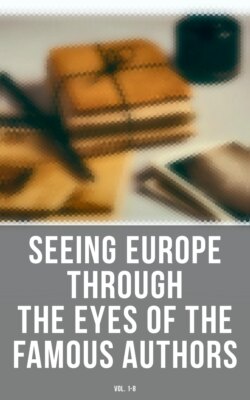Читать книгу Seeing Europe through the Eyes of the Famous Authors (Vol. 1-8) - Генри Джеймс - Страница 24
На сайте Литреса книга снята с продажи.
DURHAM1 By Nathaniel Hawthorne
ОглавлениеTable of Contents
Durham Cathedral has one advantage over the others I have seen, there being no organ-screen, nor any sort of partition between the choir and nave; so that we saw its entire length, nearly 500 feet, in one vista. The pillars of the nave are immensely thick, but hardly of proportionate height, and they support the round Norman arch; nor is there, as far as I remember, a single pointed arch in the cathedral. The effect is to give the edifice an air of heavy grandeur. It seems to have been built before the best style of church architecture had established itself; so that it weighs upon the soul, instead of helping it to aspire. First, there are these round arches, supported by gigantic columns; then, immediately above, another row of round arches, behind which is the usual gallery that runs, as it were, in the thickness of the wall, around the nave of the cathedral; then, above all, another row of round arches, enclosing the windows of the clerestory.
The great pillars are ornamented in various ways—some with a great spiral groove running from bottom to top; others with two spirals, ascending in different directions, so as to cross over one another; some are fluted or channeled straight up and down; some are wrought with chevrons, like those on the sleeve of a police inspector. There are zigzag cuttings and carvings, which I do not know how to name scientifically, round the arches of the doors and windows; but nothing that seems to have flowered out spontaneously, as natural incidents of a grand and beautiful design. In the nave, between the columns of the side aisles, I saw one or two monuments. …
I left my seat, and after strolling up and down the aisle a few times sallied forth into the churchyard. On the cathedral door there is a curious old knocker, in the form of a monstrous face, which was placed there, centuries ago, for the benefit of fugitives from justice, who used to be entitled to sanctuary here. The exterior of the cathedral, being huge, is therefore grand; it has a great central tower, and two at the western end; and reposes in vast and heavy length, without the multitude of niches, and crumbling statues, and richness of detail, that make the towers and fronts of some cathedrals so endlessly interesting. One piece of sculpture I remember—a carving of a cow, a milkmaid, and a monk, in reference to the legend that the site of the cathedral was, in some way, determined by a woman bidding her cow go home to Dunholme. Cadmus was guided to the site of his destined city in some such way as this.
It was a very beautiful day, and tho the shadow of the cathedral fell on this side, yet, it being about noontide, it did not cover the churchyard entirely, but left many of the graves in sunshine. There were not a great many monuments, and these were chiefly horizontal slabs, some of which looked aged, but on closer inspection proved to be mostly of the present century. I observed an old stone figure, however, half worn away, which seemed to have something like a bishop's miter on its head, and may perhaps have lain in the proudest chapel of the cathedral before occupying its present bed among the grass. About fifteen paces from the central tower, and within its shadow, I found a weather-worn slab of marble, seven or eight feet long, the inscription on which interested me somewhat. It was to the memory of Robert Dodsley, the bookseller, Johnson's acquaintance, who, as his tombstone rather superciliously avers, had made a much better figure as an author than "could have been expected in his rank of life." But, after all, it is inevitable that a man's tombstone should look down on him, or, at all events, comport itself toward him "de haut en bas." I love to find the graves of men connected with literature. They interest me more, even tho of no great eminence, than those of persons far more illustrious in other walks of life. I know not whether this is because I happen to be one of the literary kindred, or because all men feel themselves akin, and on terms of intimacy, with those whom they know, or might have known, in books. I rather believe that the latter is the case.
We went around the edifice, and, passing into the close, penetrated through an arched passage into the crypt, which, methought, was in a better style of architecture than the nave and choir. … Thence we went into the cloisters, which are entire, but not particularly interesting. Indeed, this cathedral has not taken hold of my affections, except in one aspect, when it was exceedingly grand and beautiful.
1 From "English Note Books." By arrangement with, and by permission of, the publishers of Hawthorne's works, Houghton, Mifflin Co. Copyright, 1870 and 1898.
